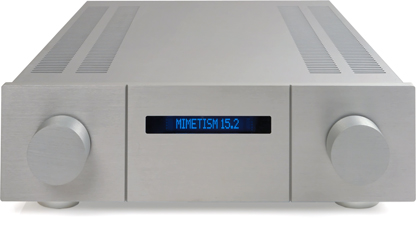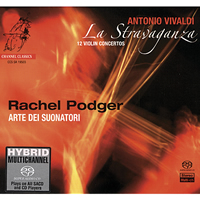FOLLOW-UP: MIMETISM 15.2 INTEGRATED AMPLIFIER
| FOLLOW-UP: MIMETISM 15.2 INTEGRATED AMPLIFIER |
| An Artisan at Work |
|
|
|
October 2007 |

During the Montreal Audio Show in 2006, I had the pleasure of interviewing William Andrea, the co-founder of the French company, Mimetism. Andrea is a renowned artisan of audiophile components, having designed such established products as the Vecteur L-4.2 CD player as well as other renowned products for YBA. In our interview, Andrea talked humbly about building his first amplifier at a young age and how since that time, his design philosophy has always been to try and find the simplest solutions to complex design challenges. While discussing his most current project (working on new schematics for designing a new “high frequency power supply that sounds good”), Andrea talked passionately about how he strives to obtain “tube sound from transistors.” Andrea expressed it this way: “Tubes have a special way with naturally separating sonic blends and this better captures the presence or aliveness that good recordings can offer.” Andrea’s goal is to bring a good slice of these virtues of tubes to his transistor based amplifier designs.
Our conversation also touched on the future of audio design and manufacturing. Andrea offered the interesting perspective that because most manufacturers of audio products now rely upon pre-designed and prefabricated components to build their own products, such cost saving measures may actually lead to a “sterile future” for design innovation in audio. Fewer resources are brought to the creative design process where common prefabricated components (as opposed to discrete components) are used across product lines. In contrast, even with the attendant greater costs of production (and thus higher price of his products), Andrea insists that Mimetism will remain an artisan company designing audio products in limited production numbers from the ground up. Only with such a model of production does Andrea believe he can still have the creative control he desires over the framework design of his products, seeking to replicate that elusive “tube aliveness” in his transistor based designs. I had a chance to audition one of Andrea’s products this past August, when I utilized Mimetism’s integrated amplifier, their model 15.2 (“15.2”) in my review of Acoustic Zen’s new Adagio Jr. loudspeakers (The Stereo Times, July, 2007 here). One can find all technical information on the 15.2 at Mutine’s website, (www.mutine.com) but in summary, the 15.2 is a 2 x 180 watts RMS 8 ohms integrated amplifier, fully controlled by digital functions. It arrived in gleaming silver casing (packed weight 65 lbs) sporting a nicely laid out front panel with a good readable display, sandwiched between two large multi purpose control knobs (designed to be pushed or rotated for accessing functions).

The rear panel contained both RCA and Balanced ins and outs, well spaced, with decently constructed Five-way speaker binding posts. The 15.2’s myriad functions (including user defined input and output labels and precisely calibrated digital volume control), are all accessed from its stunning remote control, ergonomically the best remote I have laid eyes and hands on. (The only minor shortcoming of this remote was that it lacked a mute button and a backlight and it needed some padding underneath in order to protect its heavy casing from scratching surfaces.) All in all, the 15.2 struck a sleek, beautifully crafted pose, was easy to fit on a normal sized shelf (running relatively cool), and provided elegant digital functionality and a remote control second to none.
In listening to the 15.2 driving the Acoustic Zen Adagio Jr. loudspeakers, I could still hear the resonance of William Andrea’s words in our interview regarding his design philosophies. This was because the 15.2 was the best solid state embodiment of “tactile aliveness” that I have yet encountered in a transistor-based integrated amplifier. I am not sure whether this quality came from the 15.2’s slightly warm tonal coloration overall or its lack of discernable grain top to bottom. It compared favorably to the most dynamic of solid state integrated amps I have auditioned, the MBL 7008, but with a greater overall warmth of expression. The 15.2 had no discernable darkness in its high frequencies and never sounded compressed, even at extreme SPL’s.  It also was an endearing surgeon on micro-dynamics, lending a warm, inviting hand to the close observation of musical details. Best examples were how it captured flutist Sharon Bezaly’s breathing techniques to create a fragile, shimmer of a trill (as displayed on her wonderful SACD, Bridge Across The Pyrenees [BIS 1559]) or how trumpeter Clark Terry was captured bobbing back and forth from his mic, scatting his comic chatter onPortraits [Chesky SACD 267]. Compared with the tube based Audiomat Arpege Reference integrated amplifier (at nearly half the price of the 15.2), the 15.2 was more vibrant and transparent in all bandwidths, singing with slightly less rounded notes but pulling more of the inner details and vitality out of each performance.
It also was an endearing surgeon on micro-dynamics, lending a warm, inviting hand to the close observation of musical details. Best examples were how it captured flutist Sharon Bezaly’s breathing techniques to create a fragile, shimmer of a trill (as displayed on her wonderful SACD, Bridge Across The Pyrenees [BIS 1559]) or how trumpeter Clark Terry was captured bobbing back and forth from his mic, scatting his comic chatter onPortraits [Chesky SACD 267]. Compared with the tube based Audiomat Arpege Reference integrated amplifier (at nearly half the price of the 15.2), the 15.2 was more vibrant and transparent in all bandwidths, singing with slightly less rounded notes but pulling more of the inner details and vitality out of each performance.
This was best illustrated on favorite recordings of orchestral works where intimate details are recorded with care. Best example was the life-affirming joy of Rachel Podger’s violin along with the Arte Dei Suonatori Baroque Orchestra in bringing Vivaldi to vibrant life on La Stravaganza [Channel Classics SACD 19503].  With the 15.2 in place, the music was figuratively flying in light, airy string color, with particular glory paid to the defined space between instruments on the stage. The 15.2 was exceptionally speedy on transients and every staccato note was delivered with precision and verve. Soundstage, both width and depth, was very good, although not exceptional. String basses were rendered low and pungent with the 15.2 driving either the Adagio Jr. or Harbeth Super HL5 loudspeakers, getting these smaller speakers down to their lowest abilities in my medium-sized room. However, bass definition and dynamic punch (especially on rock recordings) were slightly bettered by the (now discontinued) Mark Levinson 383 integrated amplifier, still my solid state champ in these particular areas. Finally, I did note a special quality to the 15.2 best illustrated again by the wonderful Podger violin. The 15.2 brought a new level of natural intonation or “presence” emanating from Podger’s violin strings not heard before. Notes were certainly struck clear and pristine but they also resonated and decayed naturally with full expression of what weight or emphasis Podger had placed upon her bow at that precise instant. Thus, the 15.2 offered a clear window into the artistry of this performer placing her own stamp of creativity on the musical vision of Vivaldi. This was a special trait indeed. I concluded that such a clear window into an artist’s performance on recordings that afforded such was produced by the 15.2’s exceptional way with transparency, transient speed and microdynamics.
With the 15.2 in place, the music was figuratively flying in light, airy string color, with particular glory paid to the defined space between instruments on the stage. The 15.2 was exceptionally speedy on transients and every staccato note was delivered with precision and verve. Soundstage, both width and depth, was very good, although not exceptional. String basses were rendered low and pungent with the 15.2 driving either the Adagio Jr. or Harbeth Super HL5 loudspeakers, getting these smaller speakers down to their lowest abilities in my medium-sized room. However, bass definition and dynamic punch (especially on rock recordings) were slightly bettered by the (now discontinued) Mark Levinson 383 integrated amplifier, still my solid state champ in these particular areas. Finally, I did note a special quality to the 15.2 best illustrated again by the wonderful Podger violin. The 15.2 brought a new level of natural intonation or “presence” emanating from Podger’s violin strings not heard before. Notes were certainly struck clear and pristine but they also resonated and decayed naturally with full expression of what weight or emphasis Podger had placed upon her bow at that precise instant. Thus, the 15.2 offered a clear window into the artistry of this performer placing her own stamp of creativity on the musical vision of Vivaldi. This was a special trait indeed. I concluded that such a clear window into an artist’s performance on recordings that afforded such was produced by the 15.2’s exceptional way with transparency, transient speed and microdynamics.
Summing up, the 15.2 brought an ease and clarity of projection to music that was infectious from top to bottom. Its slightly warm character made this light and captivating weaving of musical information even more inviting and involving. My only regret is that I did not have more time to spend with the 15.2 to drive other larger loudspeaker systems, like my newest reference, the magnificent Hansen Prince loudspeaker. However, with the few weeks that I did spend with it, the 15.2 certainly put a spell on me. Andrea’s artisan vision and exceptional craft is alive and well in the 15.2. It deserves an audition if you are shopping in this lofty price range for an integrated amplifier that is beautifully crafted and which captures a good slice of that elusive, tactile sense of “aliveness” found on our favorite recordings.

___________________
Specifications
Power Output: 2 x 180 watts RMS 8 ohms; 1000 VA power supply/in-4
Harmonic distortion: .0007% @ 0dBr; .070% @-30 dBr
Signal to Noise Ratio: 100dBr
Residual Noise: 20 Hz to 22 kHz 46 uV balanced; 46 uV unbalanced
Input Impedance: 100k (balanced); 50k (unbalanced)
Voltage Gain: 34.4 V (30.7 db) into 8 ohms; 27.1 V (28.7dB) into 4 ohms
Input Sensitivity: 1.0 V rms for 150W into 8 ohms; .9V rms for 150 watts into 4 ohms
Dimensions: 16.2”(W) x 4.3”(D) x 16.9”(H)
Weight: Shipping: 62 lbs.
Price: $6,990.00
Company Information:
Mimetism Audio
Website: www.mimetism.com
Email: info@mimetism.com
Canada & USA Distribution:
Mutine Inc.
Telephone and Fax: (514) 221-2160
Website: www.mutine.com
Email: mail@mutine.com
![]()
Don’t forget to bookmark us! (CTRL-SHFT-D)
Stereo Times Masthead
Publisher/Founder
Clement Perry
Editor
Dave Thomas
Senior Editors
Frank Alles, Mike Girardi, Russell Lichter, Terry London, Moreno Mitchell, Paul Szabady, Bill Wells, Mike Wright, and Stephen Yan,
Current Contributors
David Abramson, Tim Barrall, Dave Allison, Ron Cook, Lewis Dardick, John Hoffman, Dan Secula, Don Shaulis, Greg Simmons, Eric Teh, Greg Voth, Richard Willie, Ed Van Winkle, Rob Dockery, Richard Doron, and Daveed Turek
Site Management Clement Perry
Ad Designer: Martin Perry





Be the first to comment on: FOLLOW-UP: MIMETISM 15.2 INTEGRATED AMPLIFIER